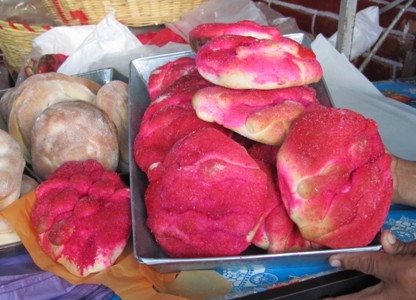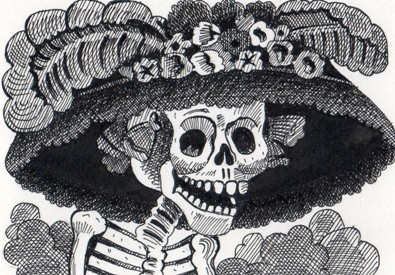
The Día de los Muertos actually spans two days, and on 1st and 2nd November every year, Mexicans throughout the country remember and honour their dear departed – children on the first day and adults on the second. Flower- and candle-bedecked altars are set out in the homes with photographs of the deceased, and in the evening the whole family gathers around the grave in the cemetery to celebrate. More candles are lit, the incense “copal” is burned, food and drink are set out, guitars are strummed and the “fiesta” lasts throughout the night.

The most famous symbol for the Day of the Dead is undoubtedly the macabre “La Catrina”, a fancily dressed female skeleton with a wide toothy grin under her flower and feather adorned hat, created by Mexican artist José Guadalupe Posada in the late nineteenth century – and the vendors of skeleton dolls of all sizes, shapes and attires do a roaring trade at this time of the year. The ghoulish sugar and chocolate skulls, with their glittering eyes and well-defined teeth, are another much loved seasonal treat; in the Taxco market, however, I recently found not only the traditional Day of the Dead bread or “Pán de Muerto” dyed a vibrant pink, but also another favourite delicacy, which truly shows off the Taxqueña women’s artistry and creativity: hand-made “alfeñiques”, small figurines fashioned out of a sugar and finely ground pumpkin seed paste. There are fish and piglets, birds and butterflies, hearts and crosses, fruit, sandwiches and bouquets of flowers.

They are barely an inch high and yet beautifully sculpted, with touches of colour on fins and ears, wings and petals – and having bought a generous selection, I could barely bring myself to destroy them by sinking my teeth into them! The flavour is very sweet, with a hint of nuttiness, and while the outside is crisp, the centre is soft and slightly chewy. I have no doubt that a huge amount of patience is required to make them, but perhaps one day I will have a go in order to commemorate my own dear departed – after all, the numerous stall keepers I spoke to assured me that “se aprende”, one learns, and perhaps practice makes perfect.


